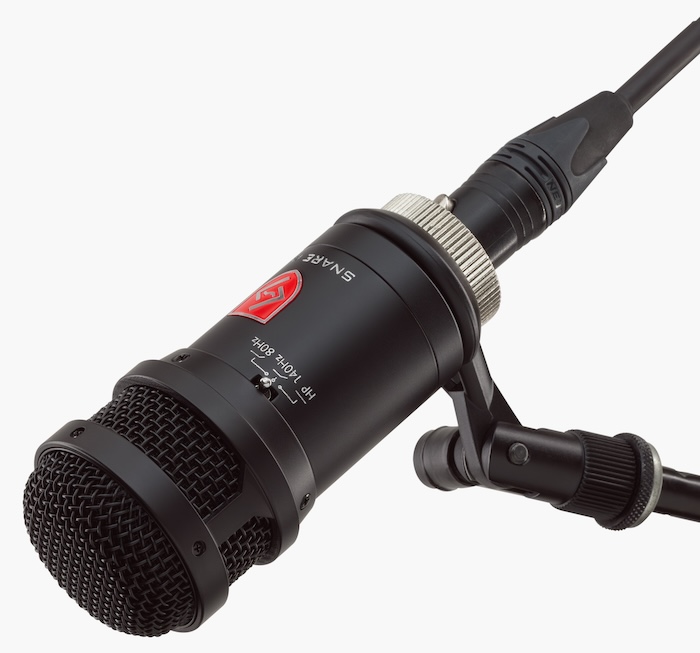
Barry's Mix Magazine Equipment And Software Reviews
Barry's Massive Discography And Engineering Career
Barry's Music Connection Magazine Reviews
Barry's Resolution Magazine Reviews
Lauten Audio Snare Mic
Versatile, full-range and Picks up minimal hi-hat leakage
By Barry Rudolph
 |
| Lauten Audio Snare Mic |
The Lauten Audio Snare Mic is a specially-designed FET condenser microphone for snare drums. It has a 32-mm diameter capsule with a cardioid polar pattern and a 20-Hz to 20-kHz response. It has up to 28dB of off-axis sound rejection (when properly positioned) to minimize leakage from the rest of the drum kit (hi-hat and cymbals) or any extraneous sounds in the studio or on live stages.
Snare Mic requires +48-volt phantom power and has a carefully tuned frequency response with ultra-high dynamic range and is capable of handling of 135dB SPL minimum for 0.5% THD. Measuring only 4.2-inches long (dimensions 112L x 71W-mm including mount), the Snare Mic makes many new placement locations possible--even impractical placements that a drummer might hit.
The included quick start is a pictorial guide with three placement suggestions as starting positions. In all three positions, the mic is aimed at the center of the snare drum but angled in degrees relative to the horizontal plane of the snare drum head when leveled at 0-degrees. The three mic placements/angles shown are: 20-30-degrees, 30-40-degrees, and 40-50 degrees. The sound obtained when using the mic placed at those angles is described. Besides exact positioning, part of getting a good snare drum sound includes "shaping" the sound with the built-in low-pass and high-pass filters.
There are a pair of three-position toggle switches on the mic's body located just below the windscreen. Switch 1 controls the starting frequency of the high-pass filter with Flat, 80-Hz, or 140-Hz positions. Switch 2 sets the starting frequency of a low-pass filter to start rolling-off with: Flat, 5-kHz, and 12-kHz.
These are smooth, 6dB/octave, low Q filters that sound great. Unlike an outboard or plug-in filter running in your DAW, these filters modify the behavior of the mic itself. Various combinations of these two switches actually change the microphone’s sensitivity above and below the cutoff frequency but without altering the "shape" of the polar pattern.
In The Studio
In all tests we setup a small drum kit and just four mics: kick, snare, and L/R condenser overheads. The snare drum was a 6 ½ X 14-inch Ludwig Black Beauty with Remo Control Sound Coated Heads. I was interested in keeping the drum kit and player consistent so as to focus on the sound of this mic. I also wanted to make sure the close-in Lauten Audio Snare Mic blended well with the other mics for excellent overall drum sound.My first test used the 20-30-degree angle and this did "increase crack and top head snap" as described in the guide. Our own "spin" on this starting placement was to set the mic about three inches directly above the rim. Immediately, we got a great sound that usually takes two mics (top and bottom) on the drum. Success!
The studio has a Trident 88 console with Lundahl mic input transformers, and only about 5 to 8dB of mic gain was required with no pad or EQ. Unless I was going for a particular sound, generally the Snare Mic required little or no additional EQ.
I tried switching in/out the filters on the mic while it was connected and up (while listening in the headphones with little or no "pop" heard. This is a full-range microphone with some of the sub-sonic energy of the kick drum easily heard. This gives you the option of removing that with HPF or not. Generally, the 80Hz position or flat were good starting positions.
The guide has the filter settings for the "Bleed Decimator" which uses both the 140-Hz high-pass and 5-kHz low-pass filters. Initially this sounded extreme but within our four-mic drum setup, most of kit's size, "air" and brightness came from a pair of AKG overhead condensers. I preferred using the 12-kHZ position for only slightly closing down the air and brightness of the snare drum. This also improves any leakage from the hi-hat--even for the hi-hat bashers you may encounter.
The Lauten Snare Mic is a very versatile microphone capable of capturing all the sound available with good fidelity and minimal hi-hat leakage. It offers many ways to further sculpt the sound.
|
|
|
|
|